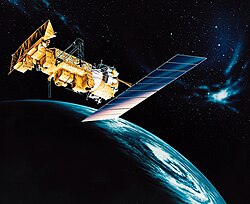 TIROS-7 satellite. | |
| Mission type | Weather satellite |
|---|---|
| Operator | NASA |
| COSPAR ID | 1963-024A |
| SATCAT no. | 604 |
| Spacecraft properties | |
| Spacecraft type | TIROS |
| Manufacturer | RCA / GSFC |
| Launch mass | 134.7 kilograms (297 lb) [1] |
| Dimensions | 1.07 m × 0.56 m (3.5 ft × 1.8 ft) |
| Start of mission | |
| Launch date | June 19, 1963, 09:50 UTC [2] |
| Rocket | Thor-Delta B 359/D-19 |
| Launch site | Cape Canaveral LC-17B |
| End of mission | |
| Last contact | June 3, 1968 |
| Decay date | June 3, 1994 |
| Orbital parameters | |
| Reference system | Geocentric |
| Regime | Low Earth |
| Eccentricity | 0.001995 [1] |
| Perigee altitude | 621 kilometers (386 mi) [1] |
| Apogee altitude | 649 kilometers (403 mi) [1] |
| Inclination | 58.23° [1] |
| Period | 97.40 minutes [1] |
| Epoch | June 19, 1963 [1] |
| Instruments | |
| Low Resolution Omnidirectional Radiometer Scanning Radiometer Langmuir probe Television Camera System | |
TIROS-7 (also called TIROS-G or A-52 ) was a spin-stabilized meteorological satellite. It was the seventh in a series of Television Infrared Observation Satellites.
